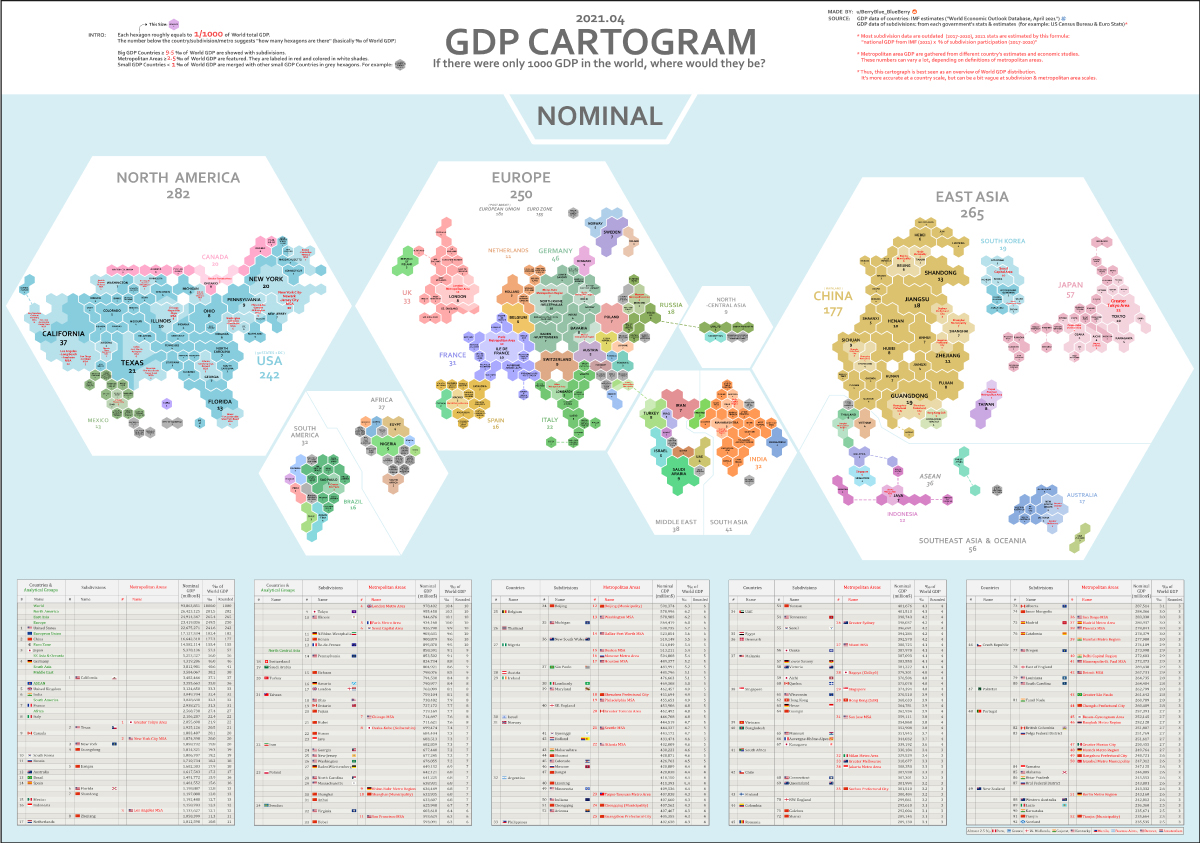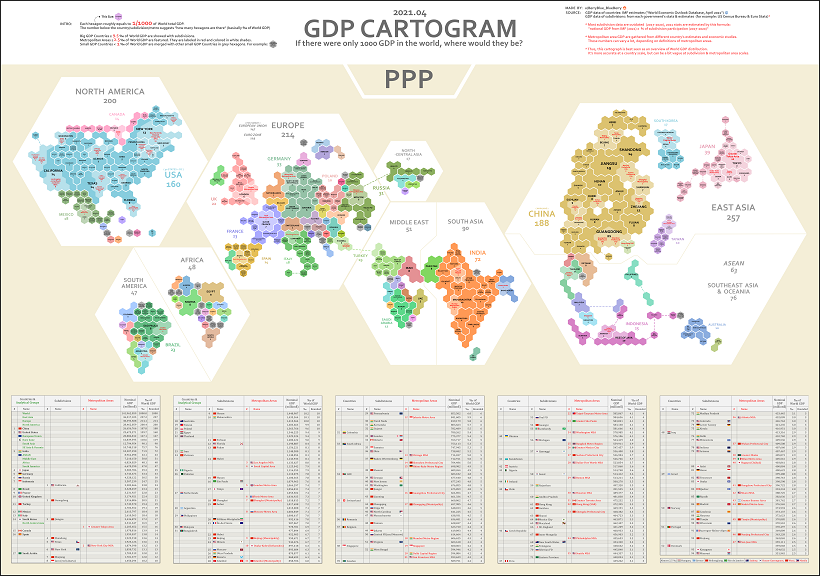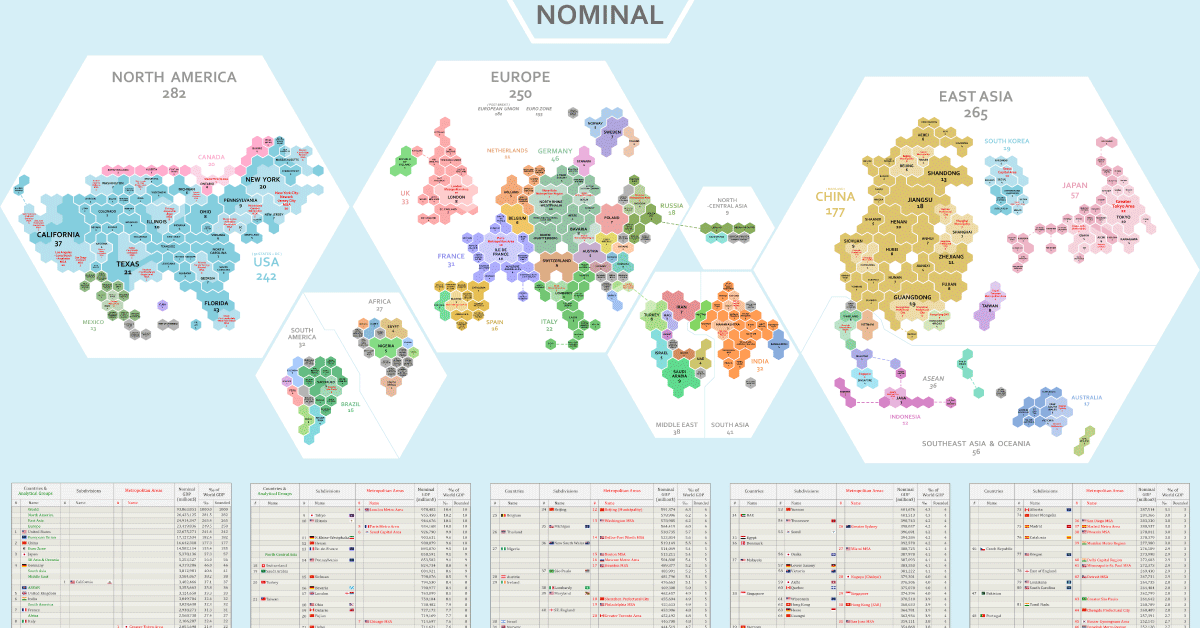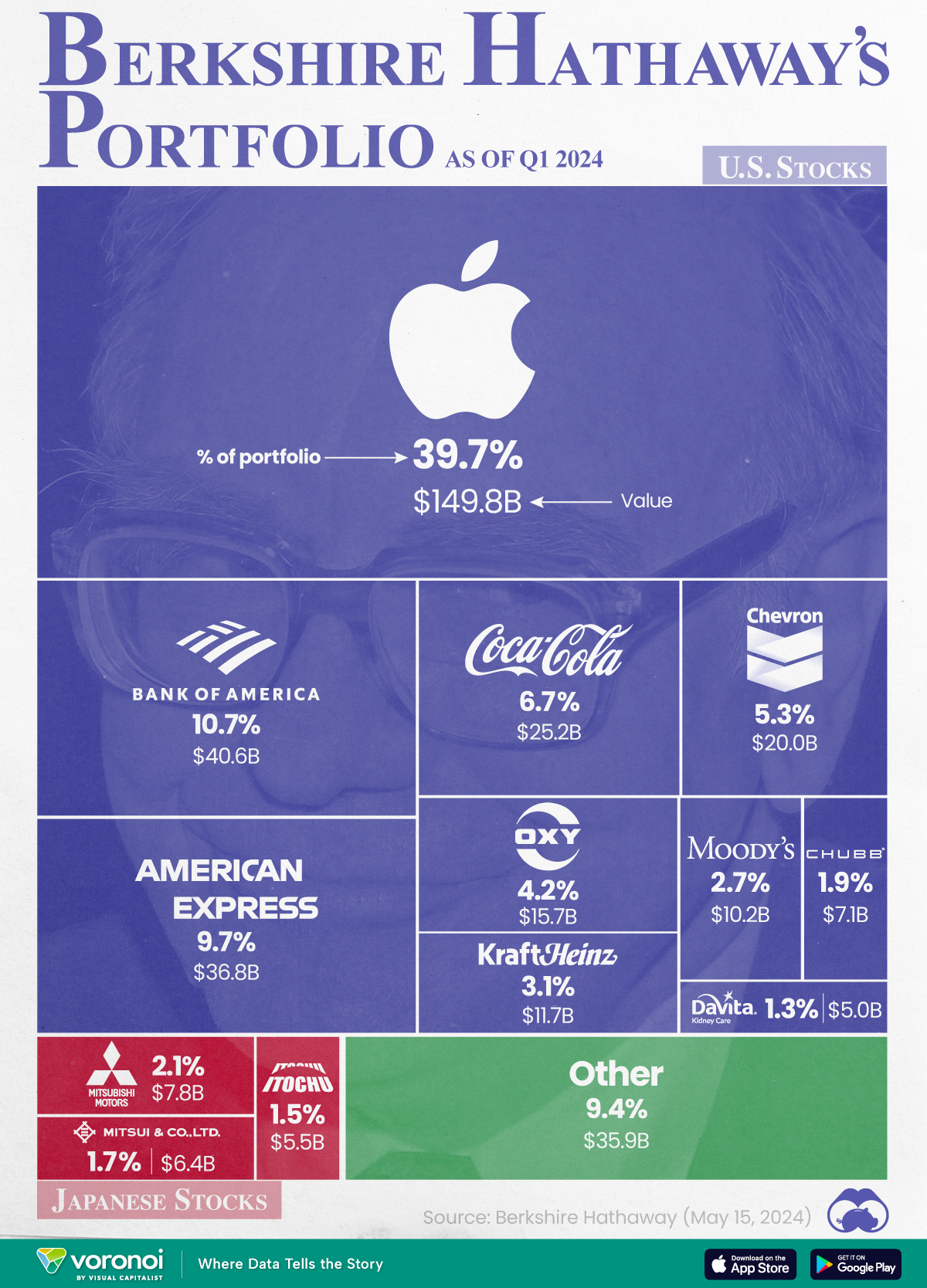Markets
Mapped: Distribution of Global GDP by Region
Mapped: The Distribution of Global GDP by Region
Gross domestic product (GDP) measures the value of goods and services that an economy produces in a given year, but in a global context, it is typically shown using country-level data.
As a result, we don’t often get to see the nuances of the global economy, such as how much specific regions and metro areas contribute to global GDP.
In these cartograms, global GDP has been normalized to a base number of 1,000 in order to show a more regional breakdown of economic activity. Created by Reddit user /BerryBlue_Blueberry, the two maps show the distribution in different ways: by nominal GDP and by GDP adjusted for purchasing power parity (PPP).
Methodology
Before diving in, let us give you some context on how these maps were designed. Each hexagon on the two maps represents 0.1% of the world’s overall GDP.
The number below each region, country or metropolitan area represents the number of hexagons covered by that entity. So in the nominal GDP map, the state of New York represents 20 hexagons (i.e. 2.0% of global GDP), while Munich’s metro area is 3 hexagons (0.3%).
Countries are further broken down based on size. Countries that make up more than 0.95% of global GDP are broken down into subdivisions, while countries that are smaller than 0.1% of GDP are grouped together. Metro areas that account for over 0.25% of global GDP are featured.
Finally, it should be noted that to account for some outdated subdivision participation data, the map creator calculated 2021 estimates for this using the formula: national GDP (2021) x % of subdivision participation (2017-2020).
Nominal vs. PPP
The above map is using nominal data, while the below map accounts for differences in purchasing power (PPP).
Adjusting for PPP takes into account the relative value of currencies and purchasing power in countries around the world. For example, $100 (or its exchange equivalent in Indian rupees) is generally going to be able to buy more in India than it is in the United States.
This is because goods and services are cheaper in India, meaning you can actually purchase more there for the same amount of money.
Anomalies in Global GDP Distribution
Breaking down global GDP distribution into cartograms highlights some interesting anomalies worth considering:
- North America, Europe, and East Asia, with a combined GDP of nearly $75 trillion, make up 80% of the world’s GDP in nominal terms.
- The U.S. State of California accounts for 3.7% of the world’s GDP by itself, which ranks higher than the United Kingdom’s total contribution of 3.3%.
- Canada as a country accounts for 2% of the world’s GDP, which is comparable to the GDP contribution of the Greater Tokyo Area at 2.2%.
- With a GDP of $3 trillion, India’s contribution overshadows the GDP of the whole African continent ($2.6 trillion).
- This visualization highlights the economic might of cities better than a conventional map. One standout example of this is in Ontario, Canada. The Greater Toronto Area completely eclipses the economy of the rest of the province.
Inequality of GDP Distribution
The fact that certain countries generate most of the world’s economic output is reflected in the above cartograms, which resize countries or regions accordingly.
Compared to wealthier nations, emerging economies still account for just a tiny sliver of the pie.
India, for example, accounts for 3.2% of global GDP in nominal terms, even though it contains 17.8% of the world’s population.
That’s why on the nominal map, India is about the same size as France, the United Kingdom, or Japan’s two largest metro areas (Tokyo and Osaka-Kobe)—but of course, these wealthier places have a far higher GDP per capita.
Markets
Visualizing Berkshire Hathaway’s Stock Portfolio (Q1 2024)
We visualized the latest data on Berkshire Hathaway’s portfolio to see what Warren Buffett is invested in.
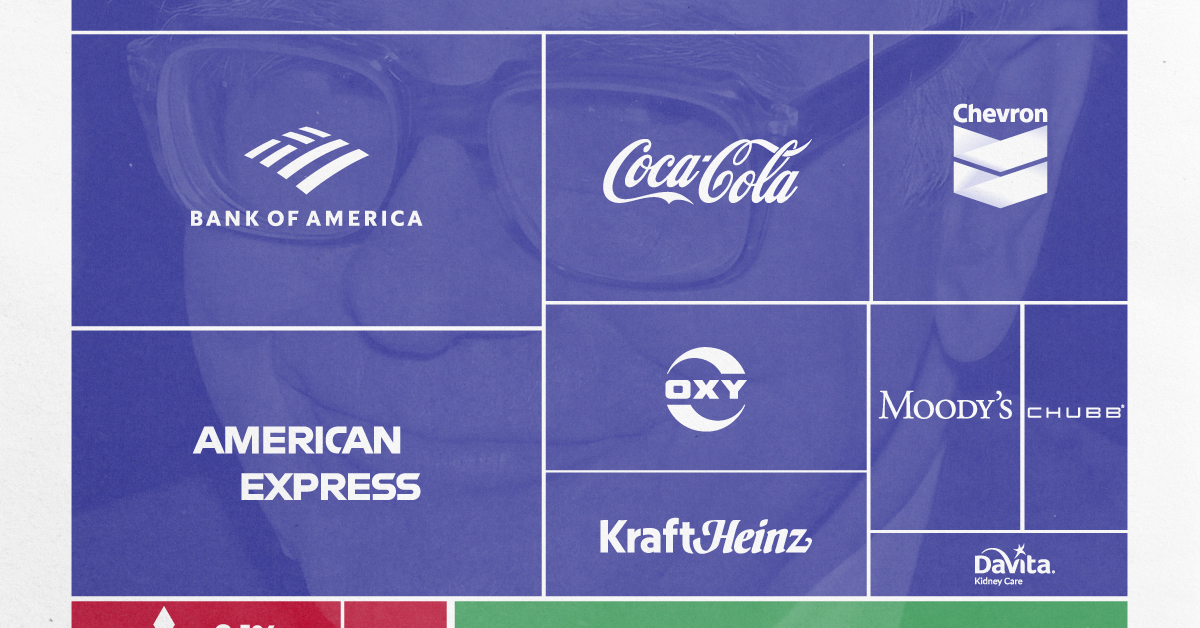
Visualizing Berkshire Hathaway’s Portfolio as of Q1 2024
This was originally posted on our Voronoi app. Download the app for free on iOS or Android and discover incredible data-driven charts from a variety of trusted sources.
Wondering what the Oracle of Omaha has his money invested in?
In this graphic, we illustrate Berkshire Hathaway’s portfolio holdings, as of Q1 2024. This data was released on May 15, 2024, and can be easily accessed via CNBC’s Berkshire Hathaway Portfolio Tracker.
The value of each position listed in this graphic is based on market prices as of May 23, 2024, and will change over time.
Furthermore, note that Berkshire has received SEC permission to temporarily withhold data on certain positions. This includes all of its Japanese stocks, which are reported as of June 12, 2023.
It’s (almost) all Apple
The data we used to create this graphic can be found in the following table. Positions worth less than $5 billion were included in “Other”.
| Company | % of Portfolio | Value (As of 05-23-2024) |
|---|---|---|
| 🇺🇸 Apple Inc | 39.7 | $149.8B |
| 🇺🇸 Bank of America | 10.7 | $40.6B |
| 🇺🇸 American Express | 9.7 | $36.8B |
| 🇺🇸 Coca-Cola | 6.7 | $25.2B |
| 🇺🇸 Chevron | 5.3 | $20.0B |
| 🇺🇸 Occidental Petroleum | 4.2 | $15.7B |
| 🇺🇸 Kraft Heinz | 3.1 | $11.7B |
| 🇺🇸 Moody’s | 2.7 | $10.2B |
| 🇯🇵 Mitsubishi Corp | 2.1 | $7.8B |
| 🇺🇸 Chubb | 1.9 | $7.1B |
| 🇯🇵 Mitsui & Co | 1.7 | $6.4B |
| 🇯🇵 Itochu Corporation | 1.5 | $5.5B |
| 🇺🇸 DaVita | 1.3 | $5.0B |
| 🌍 Other | 9.4 | $35.9B |
| Total | 100 | $377.9B |
From this, we can see that Berkshire’s largest position is Apple, which makes up almost 40% of the portfolio and is worth nearly $150 billion.
While Warren Buffett once referred to Apple as the best business in the world, his firm actually trimmed its position by 13% in Q1 2024.
Even after that cut, Berkshire still maintains a 5.1% ownership stake in Apple.
Why Japanese Stocks?
While most of Berkshire’s major positions are in American companies, Japanese firms make up a significant chunk.
In 2020, Berkshire took positions in five Japanese trading houses: Itochu, Marubeni, Mitsubishi, Mitsui, and Sumitomo.
Also known as sōgō shōsha, which translates to “general trading company”, these firms are highly diversified across major industries.
According to an article from IMD, Buffett sees an attractive opportunity in Japan due to the country’s low-interest rates, among other things.
Learn More About Investing From Visual Capitalist
If you enjoyed this graphic, be sure to check out Visualizing the Growth of $100, by Asset Class (1970-2023).
-

 Politics2 weeks ago
Politics2 weeks agoWhich Countries Have the Most Economic Influence in Southeast Asia?
-

 Brands2 weeks ago
Brands2 weeks agoHow Popular Snack Brand Logos Have Changed
-

 War2 weeks ago
War2 weeks agoVisualized: Aircraft Carriers by Country
-

 Cannabis2 weeks ago
Cannabis2 weeks agoMapped: Countries Where Recreational Cannabis is Legal
-
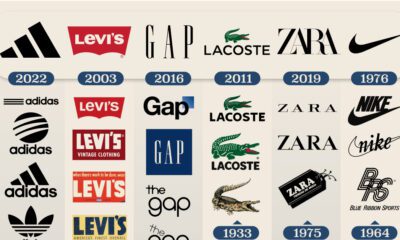
 Business2 weeks ago
Business2 weeks agoCharted: How the Logos of Select Fashion Brands Have Evolved
-

 population2 weeks ago
population2 weeks agoMapped: U.S. States By Number of Cities Over 250,000 Residents
-
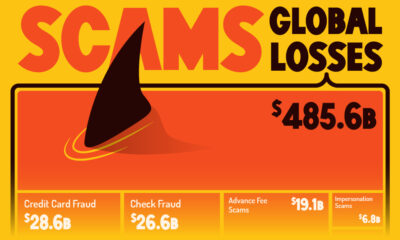
 Crime2 weeks ago
Crime2 weeks agoVisualizing Global Losses from Financial Scams
-
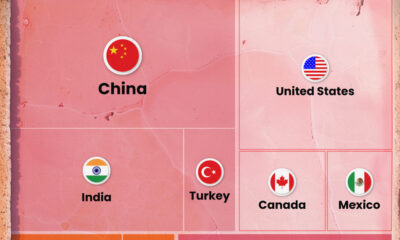
 Mining2 weeks ago
Mining2 weeks agoThe Biggest Salt Producing Countries in 2023

